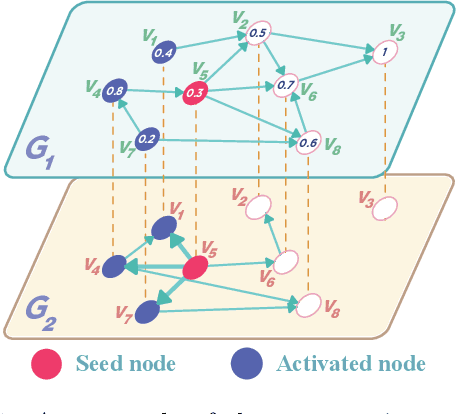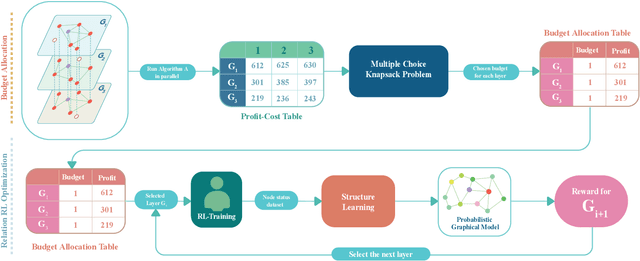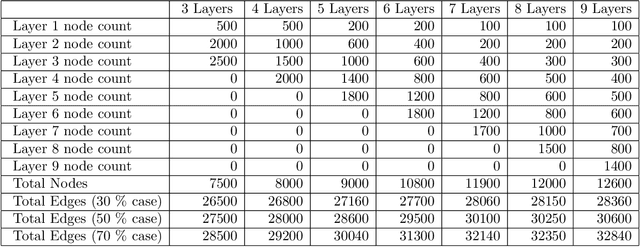Tanmoy Chowdhury
MIM-Reasoner: Learning with Theoretical Guarantees for Multiplex Influence Maximization
Mar 10, 2024



Abstract:Multiplex influence maximization (MIM) asks us to identify a set of seed users such as to maximize the expected number of influenced users in a multiplex network. MIM has been one of central research topics, especially in nowadays social networking landscape where users participate in multiple online social networks (OSNs) and their influences can propagate among several OSNs simultaneously. Although there exist a couple combinatorial algorithms to MIM, learning-based solutions have been desired due to its generalization ability to heterogeneous networks and their diversified propagation characteristics. In this paper, we introduce MIM-Reasoner, coupling reinforcement learning with probabilistic graphical model, which effectively captures the complex propagation process within and between layers of a given multiplex network, thereby tackling the most challenging problem in MIM. We establish a theoretical guarantee for MIM-Reasoner as well as conduct extensive analyses on both synthetic and real-world datasets to validate our MIM-Reasoner's performance.
Beyond One-Model-Fits-All: A Survey of Domain Specialization for Large Language Models
May 31, 2023



Abstract:Large language models (LLMs) have significantly advanced the field of natural language processing (NLP), providing a highly useful, task-agnostic foundation for a wide range of applications. The great promise of LLMs as general task solvers motivated people to extend their functionality largely beyond just a ``chatbot'', and use it as an assistant or even replacement for domain experts and tools in specific domains such as healthcare, finance, and education. However, directly applying LLMs to solve sophisticated problems in specific domains meets many hurdles, caused by the heterogeneity of domain data, the sophistication of domain knowledge, the uniqueness of domain objectives, and the diversity of the constraints (e.g., various social norms, cultural conformity, religious beliefs, and ethical standards in the domain applications). To fill such a gap, explosively-increase research, and practices have been conducted in very recent years on the domain specialization of LLMs, which, however, calls for a comprehensive and systematic review to better summarizes and guide this promising domain. In this survey paper, first, we propose a systematic taxonomy that categorizes the LLM domain-specialization techniques based on the accessibility to LLMs and summarizes the framework for all the subcategories as well as their relations and differences to each other. We also present a comprehensive taxonomy of critical application domains that can benefit from specialized LLMs, discussing their practical significance and open challenges. Furthermore, we offer insights into the current research status and future trends in this area.
Knowledge-enhanced Neural Machine Reasoning: A Review
Feb 07, 2023Abstract:Knowledge-enhanced neural machine reasoning has garnered significant attention as a cutting-edge yet challenging research area with numerous practical applications. Over the past few years, plenty of studies have leveraged various forms of external knowledge to augment the reasoning capabilities of deep models, tackling challenges such as effective knowledge integration, implicit knowledge mining, and problems of tractability and optimization. However, there is a dearth of a comprehensive technical review of the existing knowledge-enhanced reasoning techniques across the diverse range of application domains. This survey provides an in-depth examination of recent advancements in the field, introducing a novel taxonomy that categorizes existing knowledge-enhanced methods into two primary categories and four subcategories. We systematically discuss these methods and highlight their correlations, strengths, and limitations. Finally, we elucidate the current application domains and provide insight into promising prospects for future research.
DeepGAR: Deep Graph Learning for Analogical Reasoning
Nov 19, 2022Abstract:Analogical reasoning is the process of discovering and mapping correspondences from a target subject to a base subject. As the most well-known computational method of analogical reasoning, Structure-Mapping Theory (SMT) abstracts both target and base subjects into relational graphs and forms the cognitive process of analogical reasoning by finding a corresponding subgraph (i.e., correspondence) in the target graph that is aligned with the base graph. However, incorporating deep learning for SMT is still under-explored due to several obstacles: 1) the combinatorial complexity of searching for the correspondence in the target graph; 2) the correspondence mining is restricted by various cognitive theory-driven constraints. To address both challenges, we propose a novel framework for Analogical Reasoning (DeepGAR) that identifies the correspondence between source and target domains by assuring cognitive theory-driven constraints. Specifically, we design a geometric constraint embedding space to induce subgraph relation from node embeddings for efficient subgraph search. Furthermore, we develop novel learning and optimization strategies that could end-to-end identify correspondences that are strictly consistent with constraints driven by the cognitive theory. Extensive experiments are conducted on synthetic and real-world datasets to demonstrate the effectiveness of the proposed DeepGAR over existing methods.
 Add to Chrome
Add to Chrome Add to Firefox
Add to Firefox Add to Edge
Add to Edge